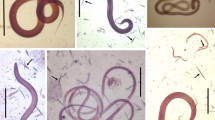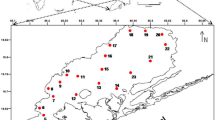Abstract
In Dutch river sediments nematodes can occur in high numbers; azoic seediments are as yet unknown. In aseries of samples takenj from the river Rhine and its estuaries, nematode density varied from 5.000 to 1.7 million per square metre, and about 50 genera were identified. Anoxic conditions appear to have less influence on the nematode abundance than the presence of ammonia. Based on nematode genera, an ecological typology of aquatic soils would appear to be feasible. The use of nematodes in environmental studies is discussed.
Similar content being viewed by others
References
BILIO, M., 1966. Die aquatischen Bodenfauna von Salzweisen der Nord- und Ostsee. II. Okologische Faunenanalyse: Hydrozoa, Nematoda, Rotatoria, Gastrotricha, Nemertini, Polychaeta, Oligochaeta, Halacaridae, Ostracoda, Copepoda. Intern. Rev. Ges. Hydrobiol. und Hydrograph., 51: 147–195.
BONGERS, T., 1988. De nematoden van Nederland, Pirola Schoort. natuurhist. Biblioth. KNNV nr. 46. 406 p.
BONGERS, T., R.G.M., DE GOEDE, F.I. KAPPERS and R. MANGER, 1989. Ecologische typologie van de Nederlandse bodem op basis van de vrijlevende nematodenfauna. RIVM-rapportnr. 718602002.
BONGERS, T., 1990. The maurity index: an ecological measure of environmental disturbance basedd on nematode species composition. Oecologia: in press.
BOUWMAN, L.A., 1978. Investigations on nematodes in the Ems-Dolart estuary. Annales Soc. r. Zool. Belg., 108: 103–105.
DE JONG, S.A., P.A.G. HOFMAN and A.J.J SANDEE, 1988. Gradïenten van fysisch-chemsiche en biologische parameters in de Rijnbodem. Rapport DIHO. 55 p.
DE WINTER, W., 1988a. Veranderingen in de nematodenfauna. In: E.H. van Nes and H. Smit. Natuurontwikkelingen Volkerakmeer/Zoommeer. Voortgangsrapport over de periode oktobe 1987 t/m februari 1988. DBW/RIZA notitie 88.029x. p. 26–30.
DE WINTER, W., 1988b. Nematodenfauna van het Volkerkmeer/Zoommeer. Rapp. Vg. Nematologie LUW — DBW/RIZA Dordrecht. 22 p.
GERLACH, S.A., 1978. Food-chain relationships in subtidal sility sand marine sediments and the role of meiofauna in stimulating productivity. Oecologia, 33: 55–69.
HEIP, C. and W. DECRAEMER, 1974. The diversity of nematode communities in the southern North Sea. Journal of the Marine Biological Association of the United Kingdom, 54: 251–255.
HEIP, C., M. VINCX and G. VRANKEN 1985. The cology of marine nematodes. Oceanogr. Mar. Biol Ann. Rev. 23: 399–489.
JACOBS, L.J., 1987a. A checklist of the Monhysteridae (Nematoda, Monhysterida). Publ. Randse Afrik. Univ. C 46 Johannesburg. 186 p.
JACOBS, L.J., 1987b. Inleiding tot de biologische kwaliteitsbeoordelling van onderwaterbodems in Nederland door middel van de Nematofauna. Vg. Nematologie LUW — DBW/RIZA.
JUARIO, J.V., 1975. Nematode species compostiion and seasonal fluctuation of a sublittoral meiofauna community in the German Bight. Veröff. Ins. Meeresforsch. Bremerth., 15: 283–337.
LOPEZ, G., F. RIEMANN and M. SCHARAGE, 1979. Feeding biology of the brackisch water oncholaimid nematodeAdoncholaimus thalassophygas. Mar. Biol., 54: 311–318.
NUSS, B., 1984. Ultrastructurelle und ökophysiologische Untersuchungen an kristalloiden Einschlüssen der Muskeln eines sulfidtoleranten limnischen Nematoden (Tobrilus gracilis). Veröff. Isnt. Meeresforsch. Bremeth., 20: 3–15.
NUSS, B. and V. TRIMKOWSKI, 1984. Physikalsiche Mikroanalysen an kristalloiden Einschlüssen beiTobrilus gracilis (Nematode, Enoplida). Veröff. Inst. Meeresforsch. Bremerh., 20: 17–27.
Prein, M., 1988. Evidence for a scavening lifestyle in the freeliving NematodePontonema vulgare (Enoplida, Oncholaimidae). Kieler Meeresforsch. Sonderh., 6: 389–394.
PREJS K.., 1977. The litoral and profundal benthic nematodes of lakes with different trophy. Ekologia Polska, 25 (1): 21–30.
RIEMANN, F. and M. SCHRAGE, 1978. The nucus-trap hypothesis on feeding nematodes and implications for biodegradation and sediemtn texture. Eecologia, 34: 75–88.
RODRIGUEZ-KABANA, R., 1986. Organic and inorganic nitrogen amendments to soil as nematods suppressants. J. Nematol., 18: 129.
SCHIEMER, F. and A. DUNCAN, 1974. The oxygen consumption of a fresh-water benthic nematode,Tobrilus gracilis (Bastian). Oecologia, 15: 121–126.
STRAATSMA, G., 1977. Orënterend onderzoek naar de bruikbaarheid van Nematoden bij de beoordeling van de waterkwaiteit van laaglandbeken. Verslag afd. Natuurbeheer (LUW) no. 432: 25 p.
TAMIS, W.L.M., 1986. Nematoden in Vlaardings Havenslib en in Papierslurrie in het Apeldooms Kanaal. Hydr. Adv. Bur. Klink. Rapp. & Meded., 22. 9 p.
TIETJEN, J.H. and J.J. LEE, 1984. The ese of free-living nematodes as a biosssay forestuarien sediments. Marine Environmental Research, 11: 233–251.
URK, G. VAN, F.C.M. LEE, 1984. The use of free-living nematodes as a bioassay for estuarine sediments. Marine Environmental Research, 11: 233–251.
URK, G. VAN, F.C.M. KERKUM and S.M. WIERSMA, 1985. Bodemfauna in verontreinigde onderwaterbodems. H20, 10 (24): 509–513.
WARWICK, R.M., 1981. Survival strategies of meiofauna. From: Jones, N.V. and W.J. Wolff: Feeding and survival strategies of estuarien organisms. Mar. Sci., 15: 39–51.
ZULLINI, A., 1976. Nematodes as indicators of river pollution. Nemat. Medit. 4: 13–22.
ZULLINI, A., 1976a. I Nematodi come bioindicatori. I. Studio di una successione. Accademia Nazionale dei Lincei. Serie VIII, LXI (5): 503–507.
ZULLINI, A. and C. RICCI, 1980. Bdelloid rotifers ad nematodes in a small italian stream. Freshwater Biology 10: 67–72.
Author information
Authors and Affiliations
Rights and permissions
About this article
Cite this article
Bongers, T., van de Haar, J. On the potential of basing an ecological typology of aquatic sediments on the nematode fauna: An example from the River Rhine. Hydrobiological Bulletin 24, 37–45 (1990). https://doi.org/10.1007/BF02256747
Issue Date:
DOI: https://doi.org/10.1007/BF02256747




